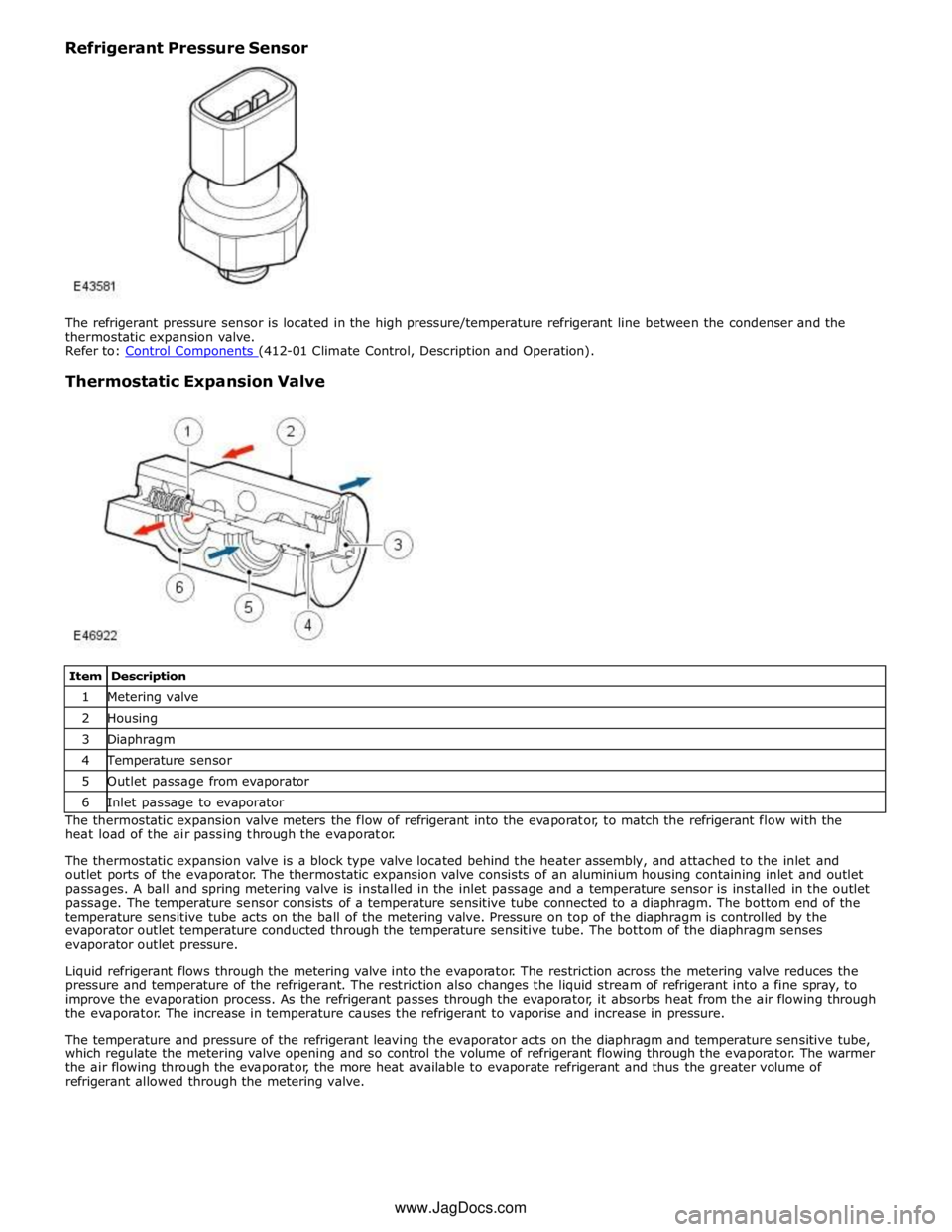2010 JAGUAR XFR refrigerant type
[x] Cancel search: refrigerant typePage 143 of 3039

DTC Description Possible Causes Action B11F0-11
Air Intake Damper
Position Sensor -
Circuit short to
ground
RECIRC servo motor air
intake feedback and 5
volt supply circuits -
short to ground
Refer to the electrical circuit diagrams and check RECIRC
servo motor air intake feedback and 5 volt supply circuits
for short to ground B11F0-15
Air Intake Damper
Position Sensor -
Circuit short to
battery or open
RECIRC servo motor air
intake feedback and
ground circuits - short
to power, open circuit
Carry out any pinpoint tests associated with this DTC using the manufacturer approved diagnostic system. Refer to the electrical circuit diagrams and check RECIRC servo motor air intake feedback and ground circuits for short to power, open circuit B11F8-00
Left Outer Vent -
No sub type
information
Left outer IP vent
actuator internal or
external fault
Carry out any pinpoint tests associated with this DTC using
the manufacturer approved diagnostic system B11F8-49
Left Outer Vent -
Internal electronic
failure
Left outer IP vent
actuator internal
electronic failure
Suspect the left outer IP vent actuator. Check and install a
new actuator as required, refer to the new
module/component installation note at the top of the DTC
Index B11F9-00
Left Inner Vent -
No sub type
information
Left inner IP vent
actuator internal or
external fault
Carry out any pinpoint tests associated with this DTC using
the manufacturer approved diagnostic system B11F9-49
Left Inner Vent -
Internal electronic
failure
Left inner IP vent
actuator internal
electronic failure
Suspect the left inner IP vent actuator. Check and install a
new actuator as required, refer to the new
module/component installation note at the top of the DTC
Index B11FA-00
Right Inner Vent -
No sub type
information
Right inner IP vent
actuator internal or
external fault
Carry out any pinpoint tests associated with this DTC using
the manufacturer approved diagnostic system B11FA-49
Right Inner Vent -
Internal electronic
failure
Right inner IP vent
actuator internal
electronic failure
Suspect the right inner IP vent actuator. Check and install a
new actuator as required, refer to the new
module/component installation note at the top of the DTC
Index B11FB-00
Right Outer Vent -
No sub type
information
Right outer IP vent
actuator internal or
external fault
Carry out any pinpoint tests associated with this DTC using
the manufacturer approved diagnostic system B11FB-49
Right Outer Vent -
Internal electronic
failure
Right outer IP vent
actuator internal
electronic failure
Suspect the right outer IP vent actuator. Check and install a
new actuator as required, refer to the new
module/component installation note at the top of the DTC
Index B11FF-84
A/C Refrigerant
Pressure - Signal
below allowable
range
Signal below allowable
range. A/C System
Refrigerant Pressure
too low
This DTC can be logged by the system due to low ambient
temperature soak (below 3°C) reducing the pressure in the
refrigerant gas system. If the cabin temperature logged
along with the DTC at the time is below 10°C this could
indicate low temperature. If the air conditioning
performance is satisfactory and the in-cabin temperature is
below 10°C then it is likely that the system contains a
suitable amount of gas and the DTC is being recorded as
an effect of the low ambient temperature. If this is not the
case carry out any pinpoint tests associated with this DTC
using the manufacturer approved diagnostic system. Refer
to the electrical circuit diagrams and check air conditioning
pressure sensor circuits for short, open circuit. Check for
correct charge weight B11FF-85
A/C Refrigerant
Pressure - Signal
above allowable
range
Signal above allowable
range. A/C System
Refrigerant pressure
too high
Carry out any pinpoint tests associated with this DTC using
the manufacturer approved diagnostic system. Refer to the
electrical circuit diagrams and check air conditioning
pressure sensor circuits for short, open circuit
Page 145 of 3039

DTC Description Possible Causes Action C1B15-13
Sensor Supply
Voltage B - Circuit
open
RECIRC servo motor
and EVAP sensor
ground circuits - open
circuit
Refer to the electrical circuit diagrams and check RECIRC
servo motor and EVAP sensor ground circuits for open
circuit P0530-11
A/C Refrigerant
Pressure Sensor A
Circuit - Circuit
short to ground
Air conditioning
pressure sensor signal
circuit - short to ground
Refer to the electrical circuit diagrams and check air
conditioning pressure sensor signal circuit for short to
ground P0530-15
A/C Refrigerant
Pressure Sensor A
Circuit - Circuit
short to battery or
open
Air conditioning
pressure sensor signal
circuit - short to power,
open circuit
Carry out any pinpoint tests associated with this DTC using
the manufacturer approved diagnostic system. Refer to the
electrical circuit diagrams and check air conditioning
pressure sensor signal circuit for short to power, open
circuit U0010-88
Medium Speed
CAN
Communication
Bus - Bus off
Bus off
Carry out any pinpoint tests associated with this DTC using
the manufacturer approved diagnostic system U0300-00
Internal Control
Module Software
Incompatibility -
No sub type
information
Invalid configuration
message is received
Re-configure the RJB using the manufacturer approved
diagnostic system. Clear the DTC and retest. If the DTC is
still logged suspect the climate control module, refer to the
new module/component installation note at the top of the
DTC Index U1A14-49
CAN Initialisation
Failure - Internal
electronic failure
Internal electronic
failure
Suspect the climate control module, check and install a
new module as required, refer to the new
module/component installation note at the top of the DTC
Index U3000-55
Control Module -
Not configured
Incorrect car
configuration data
received
Re-configure the RJB using the manufacturer approved
diagnostic system. Clear DTC and re-test. If the DTC
remains suspect the climate control module. Check and
install a new module as required, refer to the new
module/component installation note at the top of the DTC
Index U3000-87
Control Module -
Missing message
Missing message
Re-configure the RJB using the manufacturer approved
diagnostic system. Check climate control module for DTCs
and refer to the DTC Index. Carry out CAN network integrity
tests using the manufacturer approved diagnostic system.
If DTC remains suspect the climate control module. Check
and install a new module as required, refer to the new
module/component installation note at the top of the DTC
Index U3002-81
Vehicle
Identification
Number - Invalid
serial data
received
Vehicle/component
mis-match. Corrupt VIN
data being transmitted,
module previously
installed to other
vehicle
Check and install original/new module as required, refer to
the new module/component installation note at the top of
the DTC Index www.JagDocs.com
Page 1669 of 3039

8. WARNING: Refrigerant must always be recycled before re-use to ensure
that the purity of the refrigerantis high enough for safe use in the air
conditioning system. Recycling should always be carried out with
equipment which is design certified by Underwriter Laboratory Inc. for
compliance with SEA J1991. Other equipment may not recycle refrigerant
to the required level of purity. R143a Refrigerant Recover Recycling
Recharging station must not be used with any other type of
refrigerant.Refrigerant R134a from domestic and comercial sources must
not be used in motor vehicles air conditioning systems.
Allow the system to recover the refrigerant from the system.
9. Close the valves on the refrigerant station.
10. Turn the main switch 'OFF'.
11. Close the valves on the connections.
12. Disconnect the high and low pressure connections.
13. Install the dust covers to the connectors.
14. Open the tap at the rear of the station to drain the refrigerant oil.
15. Measure and record the quantity of refrigerant oil recovered from the
system.
16. Close the tap at the rear of the station.
17. Evacuation.
18. Remove the dust covers from the high and low pressure connections.
19. Connect the high and low pressure lines to the appropriate connections.
20. Open the valves on the connections.
21. Turn the valves on the station to the correct positions.
22. Turn the process switch to the correct position.
23. Turn the main switch to 'ON'.
24. Allow the station to evacuate the A/C system.
25. CAUTION: The system must be evacuated immediatley before
recharging commences. Delay between evacuation and recharging is not
permitted
Recharging
26. Close the valves on the refrigerant station.
Page 1702 of 3039

Thermostatic Expansion Valve
Item Description 1 Metering valve 2 Housing 3 Diaphragm 4 Temperature sensor 5 Outlet passage from evaporator 6 Inlet passage to evaporator The thermostatic expansion valve meters the flow of refrigerant into the evaporator, to match the refrigerant flow with the
heat load of the air passing through the evaporator.
The thermostatic expansion valve is a block type valve located behind the heater assembly, and attached to the inlet and
outlet ports of the evaporator. The thermostatic expansion valve consists of an aluminium housing containing inlet and outlet
passages. A ball and spring metering valve is installed in the inlet passage and a temperature sensor is installed in the outlet
passage. The temperature sensor consists of a temperature sensitive tube connected to a diaphragm. The bottom end of the
temperature sensitive tube acts on the ball of the metering valve. Pressure on top of the diaphragm is controlled by the
evaporator outlet temperature conducted through the temperature sensitive tube. The bottom of the diaphragm senses
evaporator outlet pressure.
Liquid refrigerant flows through the metering valve into the evaporator. The restriction across the metering valve reduces the
pressure and temperature of the refrigerant. The restriction also changes the liquid stream of refrigerant into a fine spray, to
improve the evaporation process. As the refrigerant passes through the evaporator, it absorbs heat from the air flowing through
the evaporator. The increase in temperature causes the refrigerant to vaporise and increase in pressure.
The temperature and pressure of the refrigerant leaving the evaporator acts on the diaphragm and temperature sensitive tube,
which regulate the metering valve opening and so control the volume of refrigerant flowing through the evaporator. The warmer
the air flowing through the evaporator, the more heat available to evaporate refrigerant and thus the greater volume of
refrigerant allowed through the metering valve. www.JagDocs.com